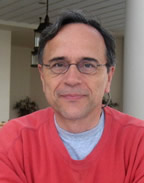

Title:
Networks of Shapes and Images
Abstract:
Across science, engineering, medicine and business we face a deluge of data coming from sensors, from simulations, or from the activities of myriads of individuals on the Internet. The data often has a geometric and/or visual character, as is the case with 1D GPS traces, 2D images and videos, 3D scans, and so on. Furthermore, the geometric data sets we collect are frequently highly correlated, reflecting information about the same or similar entities in the world, or echoing semantically important repetitions/symmetries or hierarchical structures common to both man-made and natural objects.
It is important to develop rigorous mathematical and computational tools for making such relationships or correspondences between data sets first-class citizens -- so that the relationships themselves become explicit, algebraic, storable and searchable objects. Networks of such relations can interconnect data sets into societies where the “wisdom of the collection” can be exploited in performing operations on individual data sets better, or in further assessing relationships between them. Examples include entity extraction from images or videos, 3D segmentation, the propagation of annotations and labels among images/videos/3D models, variability analysis in a collection of shapes, etc.
The talk will cover general mathematical and computational tools for the construction, analysis, and exploitation of such relational networks -- illustrated by several concrete examples using 3D models and/or images. By creating societies of data sets and their associations in a globally consistent way, we enable a certain joint understanding of the data that provides the powers of abstraction, analogy, compression, error correction, and summarization. Ultimately, useful semantic structures simply emerge from these map networks, with little or no supervision.
This ”functorial” view of geometric data puts the spotlight on consistent, shared relations and maps as the key to understanding structure in data. It is a little different from the current dominant paradigm of extracting supervised or unsupervised feature sets, defining distance or similarity metrics, and doing regression or classification – though representation sparsity still plays an important role. The inspiration is more from ideas in functional analysis and homological algebra, exploiting the algebraic structure of data relationships or maps in an effort to disentangle dependencies and assign importance to the vast web of all possible relationships among multiple geometric data sets.
Bio:
Leonidas Guibas obtained his Ph.D. from Stanford under the supervision of Donald Knuth. His main subsequent employers were Xerox PARC, DEC/SRC, MIT, and Stanford. He is currently the Paul Pigott Professor of Computer Science (and by courtesy, Electrical Engineering) at Stanford University. He heads the Geometric Computation group and is part of the Graphics Laboratory, the AI Laboratory, the Bio-X Program, and the Institute for Computational and Mathematical Engineering. Professor Guibas’ interests span geometric data analysis, computational geometry, geometric modeling, computer graphics, computer vision, robotics, ad hoc communication and sensor networks, and discrete algorithms. Some well-known past accomplishments include the analysis of double hashing, red-black trees, the quad-edge data structure, Voronoi-Delaunay algorithms, the Earth Mover’s distance, Kinetic Data Structures (KDS), Metropolis light transport, heat-kernel signatures, and functional maps. Professor Guibas is an ACM Fellow, an IEEE Fellow and winner of the ACM Allen Newell award.